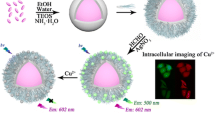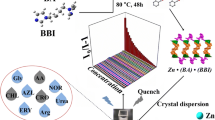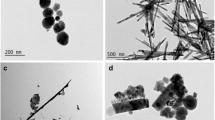Abstract
A method is described for the detection of Cu(II). It is based on the use of a room-temperature phosphorescent probe consisting of alginate-capped and manganese(II)-doped ZnS quantum dots. The carboxy groups at the surface of the probe strongly coordinate Cu(II) to form a complex. As a result, the 4T1-6A1 transition of the Mn(II) ions in the probe is quenched, and the long decay time (~2.1 ms in the unquenched state) is accordingly reduced. At excitation/emission wavelengths of 316/590 nm and a delay time of 0.1 ms, the probe shows a linear response in the 0.01 to 12 μM Cu(II) concentration range. The detection limit is 6.0 nM and the RSD is 3.2% (for n = 5).

A two-step procedure is described to synthesize alginate capped manganese doped ZnS QDs. These coordinate with Cu(II) to form an absorbent complex and can be used as a phosphorescent probe for time-resolved detection of Cu(II).






Similar content being viewed by others
References
Gözde Ö, Sezin E, Dotse SC, Merve F, Çagdas B, Fatma T, Sezgin B (2017) Sensitive determination of copper in water samples using dispersive liquid-liquid microextraction-slotted quartz tube-flame atomic absorption spectrometry. Microchem J 132:406–410
Lin TW, Huang SD (2001) Direct and simultaneous determination of copper, chromium, aluminum, and manganese in urine with a multielement graphite furnace atomic absorption spectrometer. Anal Chem 73:4319–4325
Wu J, Boyle EA (1997) Low blank preconcentration technique for the determination of lead, copper, and cadmium in small-volume seawater samples by isotope dilution ICPMS. Anal Chem 69:2464–2470
Becker JS, Matusch A, Depboylu C, Dobrowolska J, Zoriy MV (2007) Quantitative imaging of selenium, copper, and zinc in thin sections of biological tissues (slugs-genus arion) measured by laser ablation inductively coupled plasma mass spectrometry. Anal Chem 79:6074–6080
Otero-Romani J, Moreda-Pineiro A, Bermejo-Barrera A, Bermejo-Barrera P (2005) Evaluation of commercial C18 cartridges for trace elements solid phase extraction from seawater followed by inductively coupled plasma-optical emission spectrometry determination. Anal Chim Acta 536:213–218
Liu Y, Liang P, Guo L (2005) Nanometer titanium dioxide immobilized on silica gel as sorbent for preconcentration of metal ions prior to their determination by inductively coupled plasma atomic emission spectrometry. Talanta 68:25–30
Casey WQ, David MC, Daniel DM-L, Thomas R III, John V, Charles SH (2018) Solid-phase extraction coupled to a paper-based technique for trace copper detection in drinking water. Environ Sci Technol 52:3567–3573
Jonathon D, Joed EO-S, Timothy NL (2017) Copper sensing in alkaline electrolyte using anodic stripping voltammetry by means of a lead mediator. Electroanal 29:2685–2688
Ding C, Zhu A, Tian Y (2014) Functional surface engineering of C-dots for fluorescent biosensing and in vivo bioimaging. Acc Chem Res 47:20–30
Saleem M, Rafiq M, Hanif M, Shaheen MA, Seo S-Y (2018) A brief review on fluorescent copper sensor based on conjugated organic dyes. J Fluoresc 28:97–165
Zhao C, Liu B, Bi X, Liu D, Pan C, Wang L, Pang Y (2016) A novel flavonoid-based bioprobe for intracellular recognition of Cu2+ and its complex with Cu2+ for secondary sensing of pyrophosphate. Sens Actuators B 229:131–137
Li Y, Zhao Y, Chan W, Wang Y, You Q, Liu C, Zheng J, Li J, Yang S, Yang R (2015) Selective tracking of lysosomal Cu2+ ions using simultaneous target- and location-activated fluorescent nanoprobes. Anal Chem 87:584–591
Han Y, Ding C, Zhou J, Tian Y (2015) Single probe for imaging and biosensing of pH, Cu2+ ions, and pH/Cu2+ in live cells with ratiometric fluorescence signals. Anal Chem 87:5333–5339
Gao N, Yang W, Nie H, Gong Y, Jing J, Gao L, Zhang X (2017) Turn-on theranostic fluorescent nanoprobe by electrostatic self-assembly of carbon dots with doxorubicin for targeted cancer cell imaging, in vivo hyaluronidase analysis, and targeted drug delivery. Biosens Bioelectron 96:300–307
Hamd-Ghadareh S, Salimi A, Fathi F, Bahrami S (2017) An amplified comparative fluorescence resonance energy transfer immunosensing of CA125 tumor marker and ovarian cancer cells using green and economic carbon dots for bio-applications in labeling, imaging and sensing. Biosens Bioelectron 96:308–316
Zou W-S, Zhao Q-C, Zhang J, Chen X-M, Wang X-F, Zhao L, Chen S-H, Wang Y-Q (2017) Enhanced photoresponsive polyethyleneimine/citric acid co-carbonized dots for facile and selective sensing and intracellular imaging of cobalt ions at physiologic pH. Anal Chim Acta 970:64–72
Michalet X, Pinaud FF, Bentolila LA, Tsay JM, Doose S, Li JJ, Sundaresan G, Wu AM, Gambhir SS, Weis SS (2005) Quantum dots for live cells, in vivo imaging, and diagnostics. Science 307:538–544
Gedda G, Lee C-Y, Lin Y-C, Wu H-F (2016) Green synthesis of carbon dots from prawn shells for highly selective and sensitive detection of copper ions. Sens Actuators B 224:396–403
Dong Y, Wang R, Li G, Chen C, Chi Y, Chen G (2012) Polyamine-functionalized carbon quantum dots as fluorescent probes for selective and sensitive detection of copper ions. Anal Chem 84:6220–6224
Qu Q, Zhu A, Shao X, Shi G, Tian Y (2012) Development of a carbon quantum dots-based fluorescent Cu2+ probe suitable for living cell imaging. Chem Commun 48:5473–5475
Lin X, Gao G, Zheng L, Chi Y, Chen G (2014) Encapsulation of strongly fluorescent carbon quantum dots in metal-organic frameworks for enhancing chemical sensing. Anal Chem 86:1223–1228
Zong J, Yang X, Trinchi A, Hardin S, Cole I, Zhu Y, Li C, Muster T, Wei G (2014) Carbon dots as fluorescent probes for “off-on” detection of Cu2+ and L-cysteine in aqueous solution. Biosens Bioelectron 51:330–335
Zou W-S, Zhao Q-C, Kong W-L, Wang X-F, Chen X-M, Zhang J, Wang Y-Q (2018) Multi-level fluorescent logic gate based on polyamine coated carbon dots capable of responding to four stimuli. Chem Eng J 337:471–479
Li C, Liu J, Alonso S, Li F, Zhang Y (2012) Upconversion nanoparticles for sensitive and in-depth detection of Cu2+ ions. Nanoscale 4:6065–6071
Zhou J, Liu Z, Li F (2012) Upconversion nanophosphors for small-animal imaging. Chem Soc Rev 41:1323–1349
Shu T, Su L, Wang J, Lu X, Liang F, Li C, Zhang X (2016) Value of the debris of reduction sculpture: thiol etching of Au nanoclusters for preparing water-soluble and aggregation-induced emission-active Au(I) complexes as phosphorescent copper ion sensor. Anal Chem 88:6071–6077
You Y, Han Y, Lee Y-M, Park SY, Nam W, Lippard SJ (2011) Phosphorescent sensor for robust quantification of copper(II) ion. J Am Chem Soc 133:11488–11491
Wang Y-Q, Zou W-S (2011) 3-Aminopropyltriethoxysilane-functionalized manganese doped ZnS quantum dots for room-temperature phosphorescence sensing ultratrace 2,4,6-trinitrotoluene in aqueous solution. Talanta 85:469–475
Zou W-S, Sheng D, Ge X, Qiao J-Q, Lian H-Z (2011) Room-temperature phosphorescence (RTP) chemosensor and Rayleigh scattering (RS) chemodosimeter dual-recognition probe for TNT based on Mn-doped ZnS quantum dots. Anal Chem 83:30–37
Martinsen A, SkjBk-Braek G, Smidsrs¢d O (1989) Alginate as immobilization material: I. correlation between chemical and physical properties of alginate gel beads. Biotechnol Bioeng 33:79–89
Morris ER, Rees DA, Thom D, Boyd J (1978) Chiroptical and stoichiometric evidence of a specific, primary dimerisation process in alginate gelation. Carbohydr Res 66:145–154
Grant GT, Morris ER, Rees DA, Smith PJC, Thom D (1973) Biological interactions between polysaccharides and divalent cations: the egg-box model. FEBS Lett 32:195–198
Shao N, Zhang Y, Cheung SM, Yang RH, Chan WH, Mo T, Li KA, Liu F (2005) Copper ion-selective fluorescent sensor based on the inner filter effect using a spiropyran derivative. Anal Chem 77:7294–7303
Acknowledgement
This work was supported by Natural Science Foundation of China (21506002, 41673131). The authors also thanked Anhui key project of research and development plan (1704a0902006), major science and technology project of Anhui Province (17030801028) and major project of Department of Education of Anhui province (KJ2018A0513) for financial supports.
Author information
Authors and Affiliations
Corresponding authors
Ethics declarations
The author(s) declare that they have no competing interests.
Additional information
Publisher’s Note
Springer Nature remains neutral with regard to jurisdictional claims in published maps and institutional affiliations.
Electronic supplementary material
ESM 1
(DOCX 1.13 mb)
Rights and permissions
About this article
Cite this article
Zou, WS., Deng, MY., Wang, YQ. et al. Alginate capped and manganese doped ZnS quantum dots as a phosphorescent probe for time-resolved detection of copper(II). Microchim Acta 186, 41 (2019). https://doi.org/10.1007/s00604-018-3165-z
Received:
Accepted:
Published:
DOI: https://doi.org/10.1007/s00604-018-3165-z




